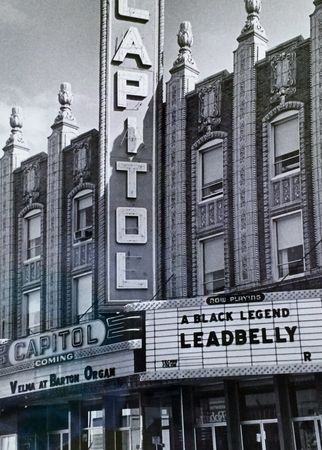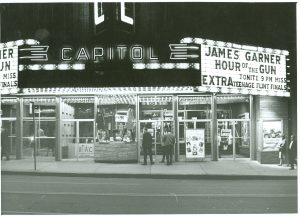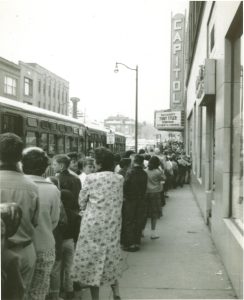History

Designed by architect John Eberson and built by Henry Vander Horst’s construction company out of Kalamazoo, FIM Capitol Theatre first opened its doors on January 19, 1928. It was the largest and most lavish theater in Flint, MI at the time, seating 2,000 and designed to bring the outside in. Eberson, who moved to the United States in 1901, was a prolific designer, and created an entirely new movie theater concept based on his exposure to European opera houses and patio performances: The Atmospheric Theater.
The inside of Capitol Theatre is breathtaking. In the lobby, the vaulted ceiling, with its painted gold blooms, welcomes crowds to gaze up. The hallways are intricately designed, with stucco walls and elegantly patterned details. As theater-goers enter the auditorium, they step into what Eberson described as an “Italian patio.” An azure sky sparkles overhead, with tiny twinkles of starlight, and faux-marble columns frame the stage. Watching over the theater from above the stage sit 10 vibrant peacocks. The architecture transports audiences to another place and time, to a cool, breezy evening in a Mediterranean garden.
The Capitol Theatre building covers three blocks, on land originally stewarded by the Sauks (Sacs), and then by the Chippewa and the Ojibwe. After changing hands throughout the 1800’s, the land was purchased by Hiram J. Bachtel for $5,000 in 1886. Bachtel tore down blacksmith shops on the property to build “Ten Cent Sheds,” shelters for off-duty carriage horses. Within decades, however, horse-drawn carriages became a thing of the past, and the automobile gained in popularity. Bachtel sold the land and eventually the Flint Building Corporation purchased it in 1923. The theatre was completed in 1928, and was purchased by Col. W. S. Butterfield of Butterfield Theater, Inc. He had worked for almost 20 years to open a theater in Flint, designating Capitol Theatre as just the place to present touring acts on their way to Chicago from Detroit.

The Capitol building was a marvel and focal point of the city, welcoming Flint’s growing population with a variety of performances and events, and housing an arcade of 11 stores, 50 offices, and a recreational basement with bowling alleys and billiard tables. As the auto industry took off, and as the population grew, so did the need for entertainment and enjoyment. Capitol Theatre, in its 100-year history, has seen every kind of performer imaginable. The theatre has housed diverse performers and acts, including singer/composer “Little” Jack Little and actress Clara Kimbell Young (1928), to Mel Tillis and the first show of AC/DC’s United States tour (1977), to beauty contests and teenage dance nights, and of course, films.
 In 1977, George Farah purchased the theatre complex. The architecture and sandstone colors reminded Farah of his former home in Jerusalem, and he renamed it “The Jerusalem Capitol Theatre.” Farah and his family owned and operated the theatre for over 40 years, showcasing rock and roll, punk, hip hop, and heavy metal bands, as well as running The Lobby, a college bar and hangout. In 1985, Capitol Theatre was listed on the National Register of Historic Places.
In 1977, George Farah purchased the theatre complex. The architecture and sandstone colors reminded Farah of his former home in Jerusalem, and he renamed it “The Jerusalem Capitol Theatre.” Farah and his family owned and operated the theatre for over 40 years, showcasing rock and roll, punk, hip hop, and heavy metal bands, as well as running The Lobby, a college bar and hangout. In 1985, Capitol Theatre was listed on the National Register of Historic Places.
The Capitol complex was sold in 2015 to The Friends of the Capitol Theatre, a subsidiary of Uptown Redevelopment Corp. The Mott Foundation funded a $15 million grant to begin restoring the Theatre architecturally and structurally, with additional generous funding by the MEDC and the Hagerman Foundation. The restoration was completed in 2017.
Capitol Theatre is one of five performing arts venues connected with FIM, including FIM Whiting Auditorium, FIM Elgood and Bower Theatres, and MacArthur Recital Hall at FIM Dort Music Center.